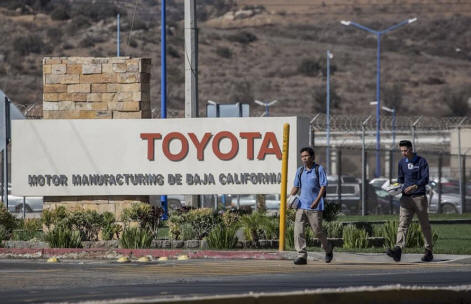|
Factories
across
Mexico,
but
particularly
northern
Mexico
are
likely
to feel
the
impact
of U.S.
tariffs,
which
went
into
effect
Tuesday.
(Aberu.go/Shutterstock)
|
|
|
|
|
|
 |
 |
 |
|
|
|
|
|
|
|
|
|
|
| |
Northern
Mexican
states
will
feel the
greatest
impact
from US
tariffs.
Here's
why
By
Agustina
Lopez
Castro -
Mexico
Tell Us
Mexico
MEXICO
CITY -
The
introduction
of a 25%
tariff
by the
United
States
on
imports
from
Mexico
is
expected
to have
significant
repercussions
for
Mexico's
economy,
particularly
for the
10
states
most
reliant
on
export-oriented
manufacturing.
These
states,
located
largely
in the
northern
and
central
Bajío
regions—such
as Baja
California,
Chihuahua,
Sonora,
and
Nuevo
León—are
particularly
vulnerable
because
over 20%
of their
GDP
depends
on trade
with the
U.S.,
primarily
in
sectors
like
auto
manufacturing.
1.
Impact
on
Export-Oriented
States
The most
affected
states—such
as Baja
California,
Chihuahua,
Sonora,
Coahuila,
Nuevo
León,
and
Tamaulipas—rely
heavily
on
industries
that
directly
trade
with the
U.S.
These
states
are home
to major
production
hubs for
automobiles
and
electronics,
industries
that are
tightly
interlinked
with
supply
chains
across
the
border.
For
example,
many of
these
regions
have
maquiladoras
(factories
for
foreign
firms)
that
assemble
products
for
export
to the
U.S. A
25%
tariff
could
disrupt
these
operations
by
making
Mexican
exports
less
cost-competitive,
forcing
companies
to
reassess
their
supply
chains
and
consider
alternative
locations.
In these
states,
local
economies
are
intertwined
with
U.S.
trade to
such a
degree
that
significant
tariffs
could
lead to
job
losses,
reduced
industrial
output,
and a
decrease
in
public
revenue.
For
instance,
Coahuila
and
Nuevo
León
have
seen
massive
investments
from
international
automotive
companies
in
recent
years.
Tariffs
could
cause
these
companies
to
curtail
production
or shift
focus to
non-Mexican
plants.

Steel
manufacturing
is
another
Mexican
industry
expected
to be
hard hit
by U.S.
tariffs.
(Alto
Hornos
de
Mexico)
2.
Vulnerable
Sectors
Transportation
equipment
manufacturing,
including
the
automotive
sector,
is
singled
out as
the most
vulnerable.
This
includes
the
production
of motor
vehicles,
trailers,
and
specialized
machinery.
Electrical
equipment
manufacturing—another
crucial
sector—is
also
poised
to take
a hit,
as
Mexico
plays a
significant
role in
assembling
components
like
wiring
systems,
batteries,
and
sensors
for
export
to the
U.S.
Steel
and
aluminum
industries,
already
under
strain
from
previous
global
trade
disputes,
would
feel
further
pressure
due to
increased
costs
and
reduced
demand.
3.
Regional
Economic
Diversity
States
like
Hidalgo
and
México
state,
with
more
diverse
economies,
show
resilience
against
the
direct
effects
of
tariffs.
Their
GDPs are
not
dominated
by
export-driven
sectors,
and
their
reliance
on trade
with the
U.S. is
comparatively
limited
(10–20%
of GDP).
This
diversity
could
shield
them
from the
immediate
shock,
but the
overall
market
uncertainty—such
as
hesitancy
from
international
investors—remains
a
concern.

A Toyota
automotive
plant
located
in the
northern
city of
Tijuana.
(Baja
California)
(Omar
Martínez/Cuartoscuro)
4.
Effects
on
Private
Investment
The
uncertainty
caused
by the
tariffs
could
lead
foreign
investors
to hold
off on
reinvestment
or
expansion
plans in
Mexico.
Gabriela
Siller
from
Banco
Base
highlighted
that
diminished
foreign
reinvestment
could
hit
northern
Mexico
especially
hard, as
this
region
has
historically
attracted
multinational
corporations
for its
skilled
workforce
and
proximity
to the
U.S.
This
could
also
hinder
Mexico’s
ability
to
compete
with
other
regions,
such as
Southeast
Asia,
that are
vying
for
global
manufacturing
investments.
5.
Long-Term
Competitiveness
The
broader
implications
of these
tariffs
go
beyond
immediate
economic
impacts.
The
Mexican
Institute
for
Competitiveness
(IMCO)
warns of
rising
production
costs,
which
could
erode
Mexico's
global
competitiveness.
For
industries
like
automotive,
aerospace,
and
electronics—where
cross-border
integration
is
critical—trade
barriers
could
force
businesses
to
reassess
their
North
American
operations,
with
potential
repercussions
for jobs
and
economic
growth
on both
sides of
the
border.
|
|
|
|
|
|
|
|
|